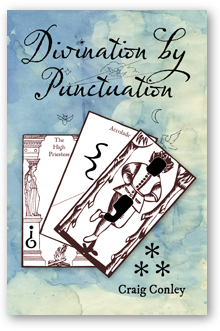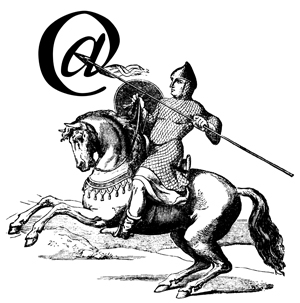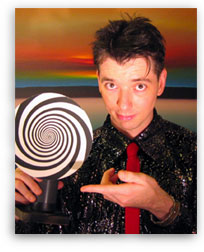|

|
Divination by Punctuation  Whether as pictographs or basic elements of language, Tarot cards form distinct units of meaning. One card may indeed establish a word, two cards may construct a compound word or phrase, and three or more cards may constitute a sentence or sentences.
Whether as pictographs or basic elements of language, Tarot cards form distinct units of meaning. One card may indeed establish a word, two cards may construct a compound word or phrase, and three or more cards may constitute a sentence or sentences.While any one card is easy enough to “translate” in isolation, the challenge is to make sense of the “deep structure” that organizes the several cards of the spread. A secondary system of icons can provide vital clues as to how individual cards relate. That system is our treasury of punctuation marks. Punctuation marks help us to pinpoint the precise structure of the sentences that constitute our life story. Punctuation helps to organize and emphasize the themes at play. It assists us to comprehend the relationships that exist between nouns (the people, places, and things in our lives) and verbs (actions and occurrences). Punctuation can connect, isolate, confirm, limit, regulate, contrast, motivate and animate the flow of information — our intelligence. In other words, punctuation offers cues on how to understand the course of our experiences. A punctuation icon may be drawn randomly from the deck and placed between any two Tarot cards whose relationship is in question. Alternately, one or more punctuation icons may be placed between cards according to the reader’s intuition. With the placement of punctuation, the cards may be read as whole sentences rather than fragments. This book oulines a method for placing punctuation in a Tarot spread, describes the meaning of punctuation (in both the upright and reversed cases), presents a Punctuated Tarot system blending punctuation icons with tarot archetypes, and provides six other techniques of Divination by Punctuation.  CONTENTS
CONTENTS
PRAISE FOR DIVINATION BY PUNCTUATION “Punctuation in tarot decks! There is much to say about it.” —Quimby’s Bookstore (Chicago) “Some intuitions are worth the whole book!” —Paolo I. “Indeed, it is all in the cards — the Tarot cards, and the Punctution Cards. The Tarot is a system that reflects archetypal energy — energy that is common to all mankind. Each card carries traditional imagery, synbology, and meaning. The cards tell a story — a story that is made up of words put together into sentences. The story that is Tarot can be made up of one card, or multiple cards. Conley writes in a clear, concise manner on a subject that is by nature esoteric. He shows the reader how to take the magic that is the Tarot, insert the magic that is Punctuation, and open up a whole new world of understanding. He defines the punctuation marks that he uses (we use these marks each and every day, but most of us really don't understand fully ‘why’ we use them the way that we do), and shows by example how as few as two Tarot cards, and one additional card - a punctuation card - can gift the reader with a whole new path of discovery. In addition to associating each of the twenty-two Major Arcana cards with a specific point of punctuation, Conley, at the end of the book, does a short take on six other ways in which punctuation can be used in divination: (1) Decipher Your Dog’s Character by the Punctuation Spots, (2) A Tilde in a Teacup: Punctuate Tealeaf Reading, (3) Automatic Punctuating, (4) Punctuation in Palmistry, (5) Punctuated Cloud Divination and (6) Visionary Punctuation: Mystical Insights. This book is a joy to work with for anyone that wants to expand their view of the world around them.” —Bonnie Cehovet THE PUNCTUATED TAROT Tarot cards are like rebus puzzles, their pictures forming coded messages. “The practical language of Tarot is a language of question and answer. In that language, card meanings could be compared to the words, and spreads to the grammar” (Ruth Ann Amberstone & Wald Amberstone, Tarot Tips, 2003). Punctuation helps to bring clarity to the meaning of a sentence. Hence, the Punctuated Tarot: each card of the Major Arcana offers a different symbol for disambiguation. Read more about the Punctuated Tarot and draw your own three-card spread online » |
|||||||||||||||||||||||||||||||||||||||||||||
 |
About the AuthorCraig Conley is a magic enthusiast and scholar. Recognized by Encarta as “America’s most creative and diligent scholar of letters, words and punctuation,” his intensive and eccentric research has led him to compile a true masterwork entitled Magic Words: A Dictionary. He has also authored One-Letter Words: A Dictionary, among other strange and unusual lexicons, and is a regular columnist for Pentacle magazine. Conley’s ideas are often decades ahead of their time. He invented the concept of the “virtual pet” in 1980, fifteen years before the debut of the popular “Tamagotchi” in Japan. His virtual pet, actually a rare flower, still thrives and has reached an incomprehensible size. Featured Works: Published Works |
|||||||||||||||||||||||||||||||||||||||||||||
|
|
Online Resources |
|||||||||||||||||||||||||||||||||||||||||||||
A free daily symbolic outlook
|
||||||||||||||||||||||||||||||||||||||||||||||